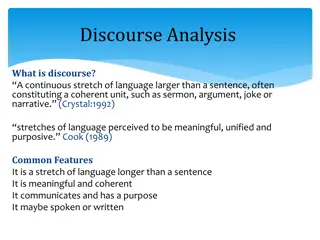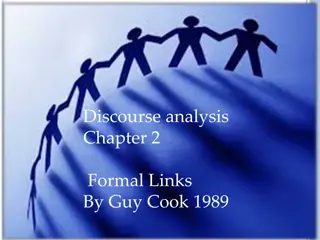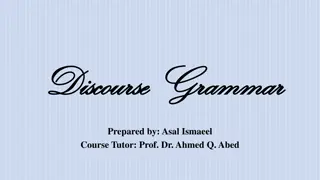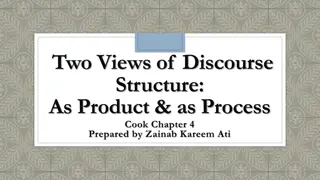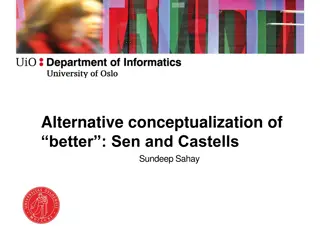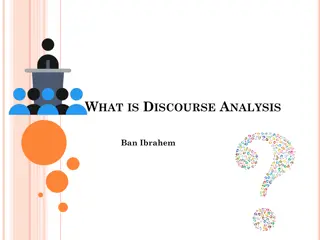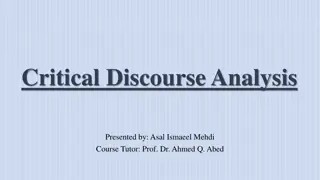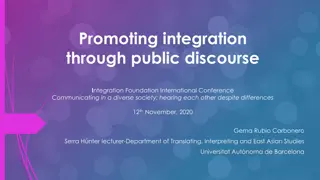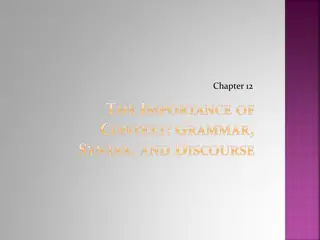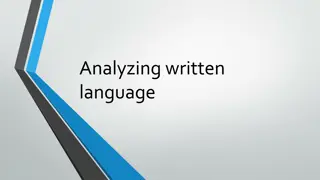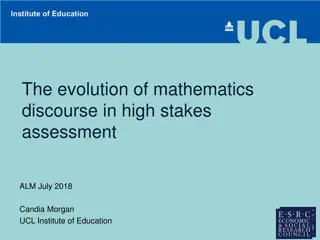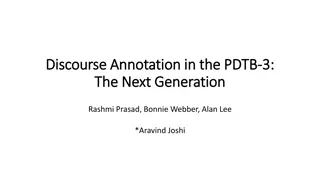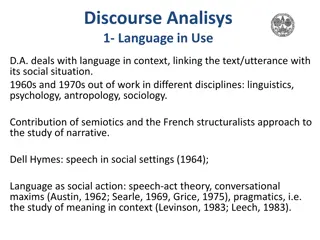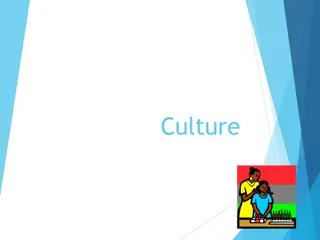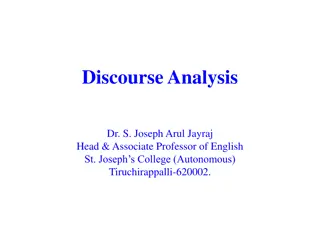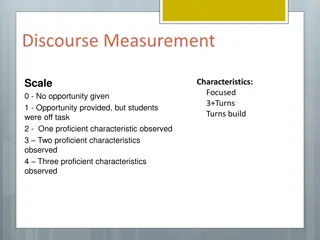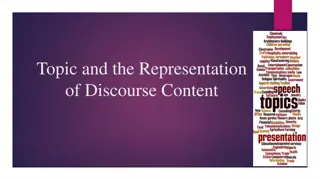Cultural Perspectives on Time Conceptualizations in Business Discourse
Figurative language plays a significant role in business communication, reflected in economic metaphors across various domains. This study examines metaphors in British and Romanian business press to uncover cultural nuances in conceptualizing time. Through a cognitive lens, the research aims to identify cultural specificities and similarities, emphasizing the influence of collective mindsets on language use.
Download Presentation

Please find below an Image/Link to download the presentation.
The content on the website is provided AS IS for your information and personal use only. It may not be sold, licensed, or shared on other websites without obtaining consent from the author. Download presentation by click this link. If you encounter any issues during the download, it is possible that the publisher has removed the file from their server.
E N D
Presentation Transcript
Conceptualisations of TIME in British and Romanian business press Teodora Popescu THE 16TH INTERNATIONAL CONFERENCE OF THE DEPARTMENT OF LINGUISTICS: ROMANIAN LINGUISTICS, ROMANCE LINGUISTICS This work was supported by a grant of the Romanian National Authority for Scientific Research and Innovation, CNCS UEFISCDI, project number PN-II-RU-TE-2014-4-2785.
Research context Main research project: Universals and variants of English and Romanian business metaphors. A corpus- based conceptual mapping of contemporary journalese from a pedagogical approach (2015-2017, University of Alba Iulia, Romania)
Presentation outline Introduction Literature review Research methodology Research results and interpretation Conclusions
Introduction Figurative language is one pervasive features of business-related communication in various settings; The communicative function of metaphor, metonymy and idioms can be found in a wide range of domains, from journal article titles, in the financial press, marketing and advertising, business presentations, negotiations, etc.; Apart from the universal cognitive concepts reflected by economic metaphors, there is an interrelatedness of semantic and social change of the language, which reflect different historical and social moments, marked by political and economic transformations; Figurative language used in business also features cultural underpinnings, revealing cultural concepts that are specific to one particular nation.
Research aims The purpose of this study is to analyse metaphors from the business discourse (found in British and Romanian business press), and to identify similarities and differences that can be assigned to cultural specificities. The main tenet is that cognitive metaphors are instantiations of cultural categories manifested in the language spoken by the community that shares a common set of characteristics within a given cultural matrix (Popescu 2012, 2015a, 2015b). In particular, I will concentrate on a specific business domain, that is the conceptualization of TIME, which, as a fundamental human concept, is very present both in the collective mind-set and the individual discourse, as well as social group manifestations.
Literature review The underlying assumption of Lakoff and Johnson s conceptual metaphor theory (CMT) is that metaphor is not only a stylistic feature of language, but they consider that thought itself is metaphorical in nature. Conceptual metaphor is a natural part of human thought, and linguistic metaphor is a natural part of human language (Lakoff & Johnson 1980: 247). Consequently, the conceptual structure of metaphors relies on correspondences or mappings between different conceptual domains. These mappings function in a natural way, as some of them are already existent in the human mind emerging from background cultural knowledge, as different kinds of similarities between concepts.
Literature review Along the same line of thought, K vecses (2005) argues that the cognitive view of metaphor can simultaneously account for both universality and diversity in metaphorical thought. He has argued that certain conceptual metaphors (for anger, time, event structure, and the self) are potentially universal or can be near-universal. He identified these as being simple or primary metaphors and/or complex metaphors based on universal human experiences (p.64). He further delves into embedded manifestations of generic level metaphors in order to prove that they are not candidates for near universal metaphors. Besides variations in conceptual metaphors at specific level, there exist others, such as when a culture uses a set of different source domains for a particular target domain, or when a culture uses a particular source domain for the conceptualization of a set of different target domains (p.67).
Literature review According to the cognitive linguistics theory, one concept is represented in our mind through a series of other concepts, which together make up a coherent whole, in the shape of a mental frame. Nevertheless, there exist social and cultural, even ideological concepts that are hardly generalizable, and as a result, they are not universal. The differences between linguistically encoded meanings in various cultures or communities are grounded in cultural models based on assumptions and patterns of thinking engendered by the varying environmental settings and differently conceptualised life experiences. In Wierzbicka s opinion (1997), linguistic universals afford a common groundwork from which variations found in various languages and cultures are created.
Literature review According to Zafiu (2001: 53), adornment to adornment, metaphor is assigned almost exclusively to descriptive passages, which themselves are little connected with the rest of the text. Journalese resorts quite often to semantic figures mainly metaphor and metonymy with an adorning or explanatory role. However, we do not usually come across extreme innovations, surprising associations from everyday life, with an aesthetic function; journalese figures rather correspond to general conceptual frameworks, analogies and associations from our daily life and from common language. These figures are already commonplace, conventionalised or become so when they are used in journalese. Clich s derived from metaphors and metonymies are often irritating through their recurrence, but have the advantage of accessibility and maximum convenience, manifested both in the production and reception of the text.
Literature review According to Coseriu (2000-2001: 20), a special relation is often established among words, attesting to their metaphoric and expressive-figurative load as well as to their associative character and collocability. Such relationships can occur either constantly or sporadically. Linguistic knowledge is often metaphorical, achieved through images which often take the same direction, which makes us think of a certain universal unity of human imagination, beyond linguistic, ethnic or cultural differences. Linguistic creation will obviously resort to other processes, such as analytic description through composition, automatic derivation, phonemic analogy, nominalisation of adjectives that appear in more or less fixed associations with certain nouns, etc. We understand metaphor not as a simple verbal transposition, a shortened comparison, but as a unitary, spontaneous and immediate (i.e. non-mediated) expression of a vision, of a poetic intuition which may entail a momentary identification of different objects, a hyperbolisation of a specific aspect of an object, or even an identification between contraries, absurd if we look at it logically, but with clearly ironic overtones in certain situations.
Research methodology The anthropological research pertaining to the influence of culture on business provides a framework of analysis heavily drawing on Geert Hofstede s (1997) cultural dimensions - Power Distance Index (PDI), Individualism (IDV), Masculinity (MAS), Uncertainty Avoidance Index (UAI), Long Term Orientation (LTO), E.T. Hall s (1966) factors influencing culture-bound behaviour (context, time, and space). My analysis is based on two corpora (British and Romanian), consisting of articles from general audience and financial broadsheets, written during 2012-2015.
Research methodology The newspapers used for this study are: The Economist, The Financial Times, The Guardian, and The Telegraph for the English corpus; and Adev rul, Adev rul Financiar, Business Magazin, G ndul, Capital, Rom nia Liber and Ziarul Financiar for the Romanian corpus. The methods employed were: quantitative analysis, based on statistical data starting from headwords and collocations frequently identified in the corpora and qualitative analysis. The instruments used were the automatic concordancing software ConcApp, various dictionaries (The Romanian Explanatory Dictionary DEX, Cambridge Dictionaries Online) and lexical datasets available online (WordNet). The size of the two corpora was comparable, i.e. approx. 500,000 words per corpus, which afforded a greater reliability to the investigation.
Research methodology The first step was to identify work-related proverbs in the two languages, after which I performed a semi-manual identification of work-related metaphors in the two corpora, using the ConcApp software, which provides concordance searches, and includes full editing support and testing activities, and also word frequency text analysis. Identification of metaphor is a time consuming process, as it entails identification of ideational meaning , by which one has to establish whether metaphors can be identified in a text and if there is some tension between a literal source domain and a metaphorical target domain (Charteris-Black 2004: 35).
Research methodology According to Stefanowitsch, there exist three main strategies for extracting linguistic expressions (as cited in Chapeton 2010): The first strategy is based on searching for source domain vocabulary. This entails selecting a potential source domain and then searching for individual lexical items from this domain using concordancers. The second one resorts to searching for target domain vocabulary. An analysis based exclusively on these two methods will only identify a subset of metaphorical expressions, namely those which contain specific vocabulary belonging to the source or target domain. The third strategy used in the extraction of metaphorical expressions is manual coding. The drawback to this method is that it limits the potential size of the corpus, as the researcher has to carefully read throughout the whole corpus. Moreover, this strategy involves manual annotation, a very time-consuming and painstaking process.
Results and interpretation The results of the investigation revealed that time-related metaphors clustered in cognitive categories account for cultural categories, both in terms of conceptual universals and variants, resulting in a complex mapping of interrelated cross-connections. Conceptualisations of TIME may be traced as back as Greek mythology, with Kronos, the king of the Titans and the God of time, who, fearing that he would be overthrown by one of his children, he swallowed all his sons as soon as they were born, hence the TIME as a DEVOURER metaphor has entered our collective mind. The TIME is a RIVER metaphor is based on the irreversible passage of time, which, just like the flowing water, will never come back.
The TIME is MONEY metaphor (1) Media outlets and sponsors retort that if women s sport attracted more interest in the first place then they would invest more time and money in it. (EC, 2014) Time is a personal resource and people will use their intelligence to spend it wisely; it is precisely this idea that marketers will exploit the need to make the female public more aware of the importance of sport among women, who could be willing to invest their individual resources into something worthwhile.
The TIME is MONEY metaphor (2) having spent lots of time and money since the crisis (EC, 2013) Time, as a resource, is confined and measurable ( lots of ), and just as in the example above, it collocates with money time and money comes as a sort of fixed expression, with a high degree of collocability. (3) people s most important resource is their time (EC, 2013) Seen as a valuable belonging, a personal resource of high importance, time needs to be respected by both its owner and the people with whom he comes in contact. Employers, friends, family, all have to understand that time is all we have got, especially in this consumerist society, where even individuals tend to become expendable.
The TIME is MONEY metaphor (4) an excess of meetings is the biggest devourer oftime (EC, 2013) Meetings, one form of spending professional time (supposedly for efficient planning and analysis of processes), if in excess, can eat up this valuable resource, and thus can become counter-productive. In this case a transfer has been made, from the traditional metaphor TIME is a DEVOURER to meetings, a specific instance of TIME, a hyponym of it, if we take the meaning of meeting as a human activity that necessitates time. (5) are a substantial waste ofthe recipients time (EC, 2015) As a resource, time can obviously misused, i.e. wasted, especially if it represents a personal belonging. Noteworthy is the fact that in this example as well the genitive is used, with reference to humans.
The TIME is MONEY metaphor (6) examine the timesaved vs. quality tradeoff by comparing the processes and outcomes of Web searches in comparison with more traditional information searches (EC, 2013) In this example, reference is made to the judicious and wise use of time, i.e. people have to weigh the advantages and disadvantages of saving time, while in some cases, this may prove a waste of time, in the end, if the outcome of the activity is not a quality one, then the time invested in that action, though apparently shorter, and at first sight, saved, will only prove to be squandered.
The TIME is MONEY metaphor (7) Greece's 130bn bailout merely buys it time... (TE, 2012) The English idiom to buy time means to postpone an event hoping that the situation will improve. In Romanian a similar idiom would be a trage de timp (Word-for-word transl. to pull time ). Time, as a resource, can be eked out, so as to be made sufficient for the owner s needs. (8) why women need to invest cash, not just time, in other women (GU, 2014) The example above also refers to investing a resource, putting it to some good use, this time investing it in humans, thus helping them appropriate it, and gaining some additional benefits. Time here is again associated with money, i.e. cash .
The TIME is MONEY metaphor (9) se face n ritm de melc provoc nd pierderi detimp i financiare de ordinul milioanelor de euro. (CA, 2015) it is carried out at a snail-like rate causing losses of time and finances amounting to millions of euros. pierderi de timp losses of time The text above provides an example of metaphor, hyperbole and personification at the same time. Time, associated with money, is a valuable resource which is wasted, due to delays in activities, which are carried at a snail-like rate, with tremendous losses amounting to millions of euros . The reader cannot help but feel the exaggeration in the text.
The TIME is MONEY metaphor (10) Iar lupta brandurilor din ziua de ast zi se petrece n doar c teva secunde, exact timpul pe care ast zi orice consumator este dispus s l aloce pentru a decide. (CA, 2012) And the fight between brands nowadays takes place over a few seconds, exactly the time that any consumer today is willing to allocate in order to make a decision. timpul s l aloce time(def.art.m.) to it allocate In the context of BUSINESS is WAR ( the fight between brands ), time flows quickly and the psychological influence over consumers buying decisions will take place very swiftly, therefore, wise use of time from the part of the marketers is crucial for their brands success. 's ' is the specific morpheme (conjunction) for the Romanian 'conjunctiv' the subjunctive mood and it is used to form both the present and perfect aspect of this predicative mood. I chose to still translate it word-for-word with the infinitive morpheme 'to' in the English language. In contemporary Romanian the subjunctive is equivalent with the infinitive, which it tends to replace. Otherwise, 's ' has no translation into English.
The TIME is MONEY metaphor (11) un z mbet for at i str mb, ncearc s c tigetimp: Mai repeta i o dat ! (SF, 2015) A crooked and forced smile, trying to gain time: Please say that again! s c stige timp to gain time Trying to gain time is a communication strategy, used in order to gather one s thoughts, to prepare an answer to a difficult, unexpected question. In this case, more time represents a gain, something that will help somebody achieve their aims. (12) RogentOS este, n fapt, un grup de programatori care au decis s idedicetimpul acestui demers. (BM, 2015) RogentOS is, in fact, a group of programmers who have decided to dedicate their time to this undertaking. s i dedice timpul to themselves dedicate time(def.art.m.) As in (1), (8), (10), people regard time as a personal asset, something that they give away as a present and the use of the reflexive pronoun strengthens this idea.
The TIME is MONEY metaphor (13) tot aparatul poli ienesc ijudec toresc ce- ipierdevremea cu prinderea i trimiterea n judecat a infractorilor. (CA, 2013) all the police and justice bodies that waste their time catching and sending to court the offenders. ce- i pierde vremea that themselves lose time Time as a resource can also be lost or misappropriated, especially if it is employed for useless, profitless activities.
The TIME is MONEY metaphor (14) 45 de minute de birou, foarte mul iconsider c timpul pierdut pe drum nu merit (CA, 2015) 45 minutes away from the office, very many consider that the time wasted on the road is not worth it. timpul pierdut pe drum time(+ def. art.m.) lost on road Time can be lost, i.e. wasted on futile activities, such as travelling to work by a certain means of transport. It is used in the context of choosing the most appropriate means of transportation, which, in the case of business people seems to be the subway, while it is possible for them to read the online press or electronic correspondence.
The TIME is MONEY metaphor (15) care ar presupune consum detimp i bani pentru to i cei implica i. (GA, 2015) which would entail consumption of time and money for all the people involved. consum de timp consumption of time Time, as any other resource can be consumed. This is another example of the association between time and money, taken as a meaningful unit, as a combined resource.
The TIME is MONEY metaphor (16) Firmele, liber-profesioni tii i contribuabilii persoane fizice din Rom nia pierd, anual, zeci sau chiar sute de milioane deorepreg tind dosare, complet nd formulare ia tept nd la r nd n fa aghi eelor. (CA, 2011) Companies, free-lancers and private individual tax-payers in Romania waste annually tens or even hundreds of millions of hours preparing files, filling in forms and waiting in queues in front of official counters. pierd milioane de ore lose millions of hours In the above example, the hyperbolic waste of time is meant to state the dimensions of the exaggerated red-tape in Romania and how it hampers the development of free enterprise and private initiative.
Discussion As can be seen, time can be invested/allocated/dedicated (to sth) (1), (8), (10), (12), wasted/consumed/lost (2), (4), (5), (9), (14), (15), (16), saved/gained (6), (7), (11), which proves that there is a universal conceptualization of time as a resource that needs to be carefully spent, apportioned, eked out. The majority of verbs collocating with timein the Romanian corpus are to waste , to lose , to consume .
Discussion The metaphorical expressions extracted above are based on the following mappings: Investment a period of time dedicated to an activity; time spent / lost in unfruitful activities; Waste accomplishing something in less time than initially calculated Saving Profit-making obtaining an extended deadline.
Discussion This set of mappings derived from the metaphor of TIME are highly conventional, which reveals that people who live by it think of time in terms of profit-making, try to invest their time in the best possible way and keep waste at a minimum. Although the metaphor TIME IS MONEY was encountered with the highest frequency rate in our corpora, the analysis showed that for the Romanian corpus it applied more to the domain of business and technology. The TIME IS MONEY metaphor can be related to the history of industrialization, when work started to be associated with the time it took to be performed (Lakoff, & Johnson 1980: 8). Consequently, its association with the business field and with that of science and technology is perfectly understandable. However, beyond these domains there are other cultural factors to be taken into account.
Discussion These results suggest that the Romanian culture emphasises more the idea of working in order to live and not the other way round, one of the characteristics of feminine cultures. In this type of culture the dominant values are caring for others and preservation, managers strive for consensus, people value equality, solidarity and quality in their working lives. Conflicts are typically resolved by compromise and negotiation and free time and flexibility are highly appreciated.
Conclusions Apart from the universal conceptualisation of time, e.g. TIME is a RIVER, whereby the flowing of the river entails that time flows beyond the possibility of return; once past, both river and time can never be brought back, there are other conceptualisations of time, assignable to different cultures. A deeper insight into the structure and meaning of metaphors can provide a better understanding of the culture that has coined them. The findings of our research are in line with Geert Hofstede s framework (1997). According to his research, data, Romania scores 42% on the masculinity/ femininity scale, while the United Kingdom registers a score of 66, indicating a masculine society. An interesting perspective might be lent by the analysis of some proverbs concerning time in both languages, and hence acquire an insight into people s attitude towards time. Such would be a higher concern of the British people for a wiser and more judicious distribution of time, whereas Romanians would be more concerned with the waste of time.
Conclusions More research needs to be done in order to establish a closer connection between the cultural categories of monchronic vs polychronic time in British and Romanian cultures. Monochronic time, or M-Time, as E.T Hall called it (1966), signifies doing one thing at a time. It assumes careful planning and scheduling. Monochronic people tend also to be low context. On the other hand, in polychronic cultures, human interaction is valued over time and material things, leading to a lesser concern for getting things done - they DO get done, but more in their own time. Romanians tend to be polychronic, and there is an anecdotal academic quarter when it comes to conceptions of punctuality. Romanians are concerned with their personal time and the need to use it as they please, especially their free time.
References Blaga, L. (2011). Trilogia culturii. Bucuresti: Humanitas. Chapeton, C. M. (2010). Identificaci n de lenguaje metaf rico en textos argumentativos en ingl s como lengua extranjera: un estudio de corpus. Folios, n.32, pp. 125-140, Retrieved 11 September, 2015, from http://www.redalyc.org/pdf/3459/345932035008.pdf. Charteris-Black, J. (2004). Corpus approaches to critical metaphor analysis. New York: Palgrave Macmillan. Co eriu, E. (2000-2001). Crea iametaforic n limbaj. Dacoromania, 11-33. Retrieved from http://www.dacoromania.inst-puscariu.ro/articole/2000-2001_1.pdf. Co eriu, E. (1997). Sincronie, diacronie i istorie. Problema schimbarii lingvistice. Bucure ti: Editura Enciclopedic . Co eriu, E. (1999). Introducere n lingvistic . Cluj Napoca: Editura Echinox, Evans, V. (2005). The meaning of time: polysemy, the lexicon and conceptual structure. Journal of Linguistics, 41, pp. 33 75. Hall, E. T. (1966). The Hidden Dimension. New York: Doubleday. Hofstede, G. (1997). Cultures and organizations: Software of the Mind. 1st edition, McGraw-Hill USA. K vecses, Z. (2005). Metaphor in culture. Universality and variation. Cambridge: Cambridge University Press. Lakoff, G. (1993). The contemporary theory of metaphor. In A. Ortony (Ed.), Metaphor and thought (2nd edition), pp. 202-251, Cambridge: Cambridge University Press.
References Lakoff, G. and Johnson, M. (1980). Metaphors we live by. Chicago: University of Chicago Press. Pickett, D. (1986). Business English: Falling between two stools. COMLON 26, 16-21. Pickett, D. (1989). The Sleeping Giant: Investigations in Business English. Language International 1(1), 5-11. Popescu, T. (2015a). Business metaphors explained. In Universals and variants of English and Romanian business metaphors. A corpus-based conceptual mapping of contemporary journalese from a pedagogical approach. Proceedings of Project kick-off meeting, T. Popescu and G.-D. Iord chescu, Eds. Bucure ti: Editura Didactic i Pedagogic , pp. 13-21. Popescu, T. (2015b). A Corpus Analysis of TIME Metaphors in British and Romanian Business Press. In Universals and variants of English and Romanian business metaphors. A corpus-based conceptual mapping of contemporary journalese from a pedagogical approach. Proceedings of Project kick-off meeting, T. Popescu and G.-D. Iordachescu, Eds. Bucure ti: Editura Didactic iPedagogic , pp. 22-49. Popescu, T. (2012). Business metaphors: A case study of Peugeot advertisements in different languages. Journal of Linguistic and Intercultural Education - JoLIE, 5, 109-124. Popescu, T. (2011). Developing business students mental lexicon in English. In T. Popescu, R. Pioariu and C. Her eg, Eds., Cross-Disciplinary Approaches to the English Language: Theory and Practice. Newcastle: Cambridge Scholars Publishing, pp. 19-30. Popescu, T. (2007). Teaching business collocations. In D. Galova, (Ed.), Languages for Specific Purposes: Searching for Common Solutions, Newcastle: Cambridge Scholars Publishing, pp.163-176. Stefanowitsch, A. (2006). Corpus-based approaches to metaphor and metonymy. In A. Stefanowitsch and S. Gries (Eds.), Corpus-based approaches to metaphor and metonymy, Berlin/New York: Mouton de Gruyter, pp. 1 16. Zafiu, R. (2001). Diversitate stilistic n rom na actual , Bucure ti: Editura Universit ii din Bucure ti.
Universitatea 1 Decembrie 1918 Alba Iulia
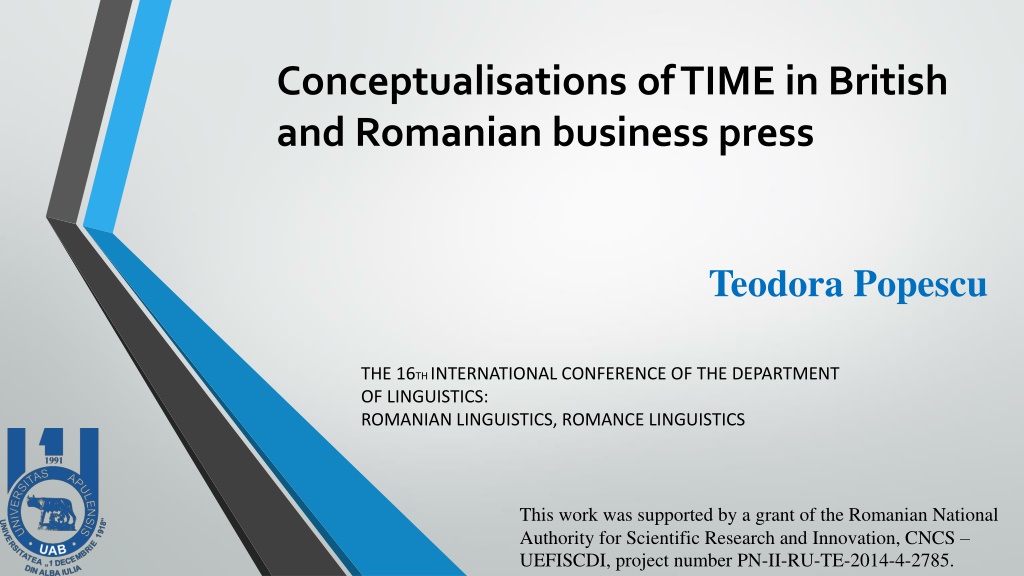
 undefined
undefined



